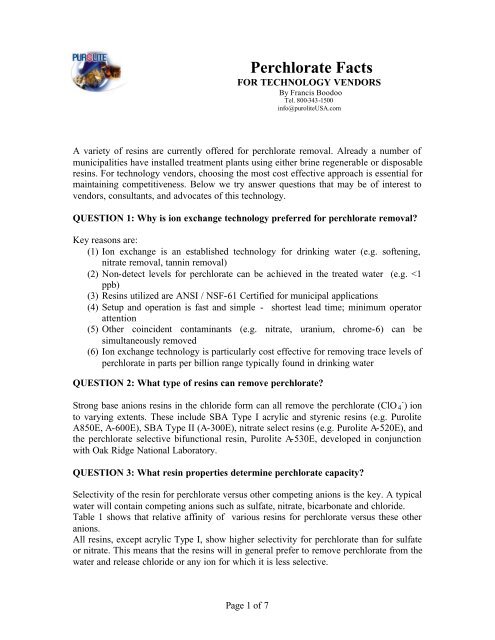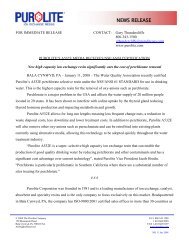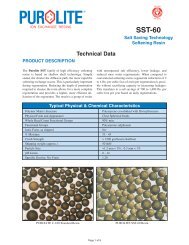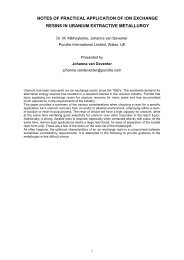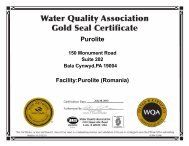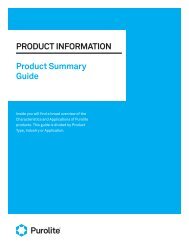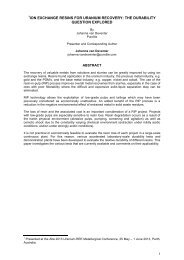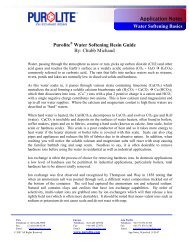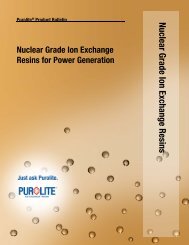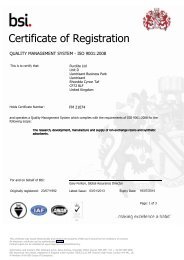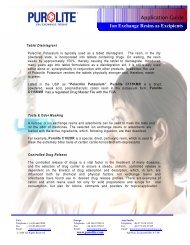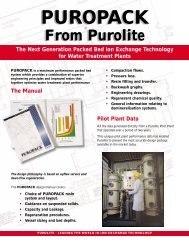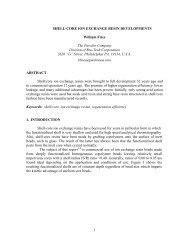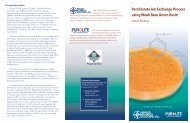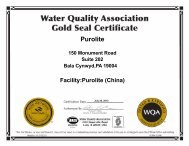Perchlorate Facts for Technology Vendors - Purolite
Perchlorate Facts for Technology Vendors - Purolite
Perchlorate Facts for Technology Vendors - Purolite
Create successful ePaper yourself
Turn your PDF publications into a flip-book with our unique Google optimized e-Paper software.
<strong>Perchlorate</strong> <strong>Facts</strong>FOR TECHNOLOGY VENDORSBy Francis BoodooTel. 800-343-1500info@puroliteUSA.comA variety of resins are currently offered <strong>for</strong> perchlorate removal. Already a number ofmunicipalities have installed treatment plants using either brine regenerable or disposableresins. For technology vendors, choosing the most cost effective approach is essential <strong>for</strong>maintaining competitiveness. Below we try answer questions that may be of interest tovendors, consultants, and advocates of this technology.QUESTION 1: Why is ion exchange technology preferred <strong>for</strong> perchlorate removal?Key reasons are:(1) Ion exchange is an established technology <strong>for</strong> drinking water (e.g. softening,nitrate removal, tannin removal)(2) Non-detect levels <strong>for</strong> perchlorate can be achieved in the treated water (e.g.
Table 1 – Affinity Relative to ChlorideResin Type <strong>Perchlorate</strong> SO4 NO3Gel Acrylic Type I 4 (A-850E) 4 – 5 ~ 11 2Gel Styrenic Type I or II 9 (A-600E, A-300E) 100 – 150 ~ 9.1 3.2Nitrate Selective (A-520E) >200 < 7 < 12BiQuat (A-530E)* >1000 < 6 < 12* a perchlorate selective resin developed and licensed by Oak Ridge National Laboratories(ORNL).”BiQuat” is a trademark of ORNLThe concentration of competing anions such as sulfate, nitrate, chloride and bicarbonateare typically about 1000 times higher than that <strong>for</strong> perchlorate (e.g. 50 ppm versus 50ppb). So despite the higher selectivity <strong>for</strong> perchlorate, a significant fraction of the ionexchange sites on the resin beads will be occupied by these competing ions, leaving littleleft <strong>for</strong> perchlorate. A small change in the concentration of these competing anions canhave a major impact on the resin’s capacity <strong>for</strong> perchlorate.There<strong>for</strong>e, it is critical to know the background water chemistry of the water ifperchlorate capacity is to be assessed (see how to do this later on).QUESTION 4: Which type of resins can be regenerated with brine?Strong base gel Acrylic Type I resins (e.g. <strong>Purolite</strong> A-850E) are economicallyregenerable with salt dosages ranging from 12 to 25 lbs per cubic foot of resin, dependingon system design. It is difficult to economically regenerate other types of resins such asstyrenic type I (e.g. <strong>Purolite</strong> A600E), type II (e.g. <strong>Purolite</strong> A300E) and nitrate selectresins (e.g. <strong>Purolite</strong> A-520E) using brine.The reason should be clear from the affinity data in Table 1 – acrylic resins have a muchlower selectivity <strong>for</strong> perchlorate than other resins, making it much easier to removeperchlorate from the resin with brine. Note that acrylic resins show higher selectivity <strong>for</strong>sulfate than <strong>for</strong> perchlorate (unlike other resins), which means that sulfate will displace orelute perchlorate from the resin as the ion exchange system operates. Thus the capacity ofacrylic resins is largely determined by the amount of sulfate in the water and the point atwhich sulfate breaks from the ion exchange column. This can be seen in Graph 1 below.Sulfate pushes both nitrate and perchlorate of the ion exchange column.In this case, perchlorate is the most selected of all anions considered and perchloratebreaks through in the effluent at about 5,000 bed volumes (note: 1 bed volume isapproximately 7.5 gallons per cubic foot of resin). Effluent and influent levels ofperchlorate equalize at about 15,000 BVs <strong>for</strong> this particular example.Page 2 of 7
Acrylic SBA TYPE I Resin<strong>Perchlorate</strong> Removal - Typical% Breakthrough300%250%200%150%100%50%0%25100175Bicarbonate250325400475550625Nitrate700775850925Bed Volumes<strong>Perchlorate</strong>Sulfate1000107511501225130013751450Graph 1 – Typical Gel Acrylic SBA Type I breakthrough – sulfate elutes perchloratGraph 2 below is typical <strong>for</strong> styrenic type I resinsStyrenic SBA TYPE I Resin<strong>Perchlorate</strong> Removal - Typical300%% Breakthrough250%200%150%100%50%0%NitrateSulfateBicarbonate<strong>Perchlorate</strong>252,9255,8258,72511,62514,52517,42520,32523,225Bed VolumesGraph 2 – Typical Styrenic SBA Type I breakthrough – perchlorate elutes lastPage 3 of 7
.QUESTION 5: Is heating the brine helpful <strong>for</strong> regeneration?Studies by the University of Houston have shown that no benefit is derived from heatingthe brine <strong>for</strong> acrylic type resins. In the case of styrenic Type I resins, some advantagesapply when the brine is heated to about 60 o C. Even then the perchlorate is not completelyremoved from the resin. Despite this they have proposed using styrenics by limiting theperchlorate loading on the resin to the equivalent of about 1800 BVs. The expectation isthat pilot studies will show that perchlorate leakage on subsequent cycles will bemaintained below the current 4 ppb target. Since this procedure is not as yet proven, it isbest to look at other alternatives at this time.QUESTION 6: What other regenerants are available?Oak Ridge National Laboratories have developed a proprietary tetrachloroferrateregeneration technique that is extremely effective in stripping the perchlorate from A-530E. Oak Ridge advises that the regenerant can be reused several times be<strong>for</strong>e theperchlorate must be destroyed. A catalytic destruct module is utilized <strong>for</strong> breakdown ofthe perchlorate into oxygen and chloride, allowing the regenerant to be reused at thatpoint after regenerant top up.Commercialization of the process is currently being sought by ORNL.The ability to regenerate the resin, when it becomes available, should significantly impactthe overall cost of perchlorate remediation.QUESTION 7: Why consider disposable resins at this time?Although acrylic Type I resin, such as <strong>Purolite</strong> A-850E, can be regenerated with brine,economical use of this resin is constrained to waters with relatively low to mediumsulfate levels. This is because the resin is more selective <strong>for</strong> sulfate than perchlorate andthe breakpoint <strong>for</strong> sulfate determines the capacity <strong>for</strong> perchlorate. For higher sulfatewaters, the capacity can typically fall to just a few hundred bed volumes (e.g. 150 to 300BVs), requiring frequent regeneration and significantly increased levels of brine to betreated, making the economics unfavorable.The alternative is to use higher capacity resins once and then incinerate it, referred to as“load and burn”.For this purpose, either A-600E (styrenic), A-520E (nitrate select), or A-530E perchlorateselective bifunctional resin can be utilized, depending on economics <strong>for</strong> each waterquality. Each job must be evaluated on a case-by-case basis since the water has such agreat impact on capacity.End users enjoy a number of advantages:Page 4 of 7
(a) disposable resin treatment systems can be quickly installed to comply withregulations(b) such plants are simple in design and require minimum operator attention(c) non-detect perchlorate levels can be achieved in the treated water (e.g. < 1ppb)(d) long term liability <strong>for</strong> perchlorate removed is eliminated by incineration of the resinQUESTION 8: Are there resin capacity and leakage curves <strong>for</strong> perchlorate?Since the water quality in each case may be different and minor variations inconcentrations of bulk anions can have a major impact on perchlorate capacity, there is noalternative but to evaluate waters on a case-by-case basis. There<strong>for</strong>e no industry curvesexist at this time.Consequently, to evaluate the capacity of specific resin <strong>for</strong> perchlorate, the followingstandard alternatives can be considered:(a) per<strong>for</strong>m laboratory, pilot and scale up studies <strong>for</strong> the specific water and resinsselected(b) repeat the same <strong>for</strong> expected variations in the water quality during thetreatment period.As is well known, the procedures above can take a long time, especially if several typesof resins must be evaluated. It is not inconceivable that several months can elapse be<strong>for</strong>eresults can be obtained.There<strong>for</strong>e a good alternative toward dramatically shortening this process is the use of ourion simulation software which has been customized <strong>for</strong> perchlorate and similar trace ions.QUESTION 9: What is <strong>Purolite</strong> Simulator Service?We make use of proprietary modeling software to estimate perchlorate capacity of each ofour <strong>Purolite</strong> resins <strong>for</strong> treating a specific water. While such modeling software cannot beexpected to be 100% accurate, the advantages it offers allow us to quickly do thefollowing:(a) compare and cost out expected treatment cost <strong>for</strong> a variety of resins(b) per<strong>for</strong>m sensitivity analyses <strong>for</strong> anticipated changes in water quality(c) evaluate changes that will occur to competing anions during service (e.g.bicarbonate, pH, nitrate)(d) assess the simultaneous loading of other trace anions that may be present inthe water (e.g. uranium, chrome-6, arsenic, selenium, etc.) <strong>for</strong> any peakingpotential above MCLs.Page 5 of 7
(e) use output data to optimize equipment sizing and frequency of resinchangeouts (in the case of disposable resins)(f) use output data to compare brine and proprietary regeneration optionsAn example short <strong>for</strong>m costing estimate is given below:IX-SIMULATOR Projection EstimatesMedium Sulfate Water Example Only:Comparing Cost to Treat 1 Acre-Foot of Water (326,000 Gallons) to
influent level after about 200 bed volumes of water have been treated. For acrylic resins,which typically treat about 500 to 700 BVs of water per cycle, this can be a substantialpart of the cycle. For the other resins with typical service cycles ranging from 10,000 to100,000 BVs, this would be very minor fraction of the water treated.Contact: Ask <strong>for</strong> Sales/Technical supportThe <strong>Purolite</strong> Company150 Monument Road, Bala Cynwyd, Pa 19004Tel. 800-343-1500; 610-668-9090; Fax 610-668-8139e-mail: info@puroliteUSA.com; http://www.puroliteUSA.comPage 7 of 7


